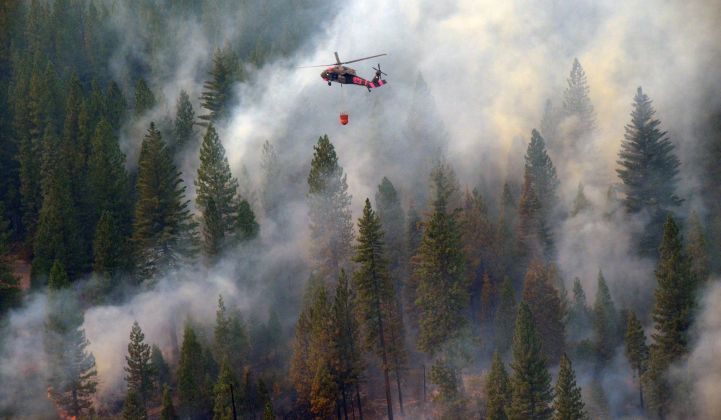Like much of the country, California is faced with a “new abnormal,” in which wildfires and other climate-related disasters are becoming more frequent and destructive. It’s exposing both the vulnerability of our existing electric system and the opportunity to use clean energy as a critical resilience strategy.
Policymakers have directed California’s major utilities to proactively shut off power as a public safety measure when fire risk is high, and the utilities have alerted their customers to be prepared for up to five continuous days without power during such a shutoff.
Think about what five days without power would mean for your family or business. Now consider what it means for people who depend on electricity-powered medical devices, for low-income families watching a week’s supply of food go bad in their fridge, or for hospitals and first responders who need power to perform their lifesaving functions.
While access to electricity affects everyone, those impacts are felt most by low-income communities, communities of color and other vulnerable populations that historically have been most impacted by, and least able to afford, the costs of climate change. So as we move into the heat of late summer when fire risk rises, anxieties are running high about the impacts of future power shutoffs, fires and other disasters that may come during our hottest season, this year and beyond.
Californians’ collective worry is a warning flag that the Golden State must adapt to unprecedented challenges and prioritize building a power grid that is more reliable, resilient and equitable. We shouldn’t accept that our first responders, emergency shelters and most vulnerable populations could go without power for days on end, or have to rely on dirty and unreliable fossil generators as their only backup.
Diesel backup generators are notoriously dirty in their emissions; during hot weather conditions and emergency situations, we should be especially careful to minimize the amount of time they are running. As Tim Edwards, president of the union that represents the state’s firefighters, wrote recently, “We must build greater resiliency into the system, and we need to move beyond the 20th century backup technology of inefficient, dirty, diesel-powered emergency generators. [...] (California) is shockingly behind in building resiliency into its system.”
The good news
The good news is that we already have the technologies we need for clean, truly reliable backup power. There are examples across the state of solar being combined with energy storage to help families, businesses and critical facilities reliably maintain power during power shutoffs.
When customers have installed solar-plus-storage and they opt to make the system “islandable,” that onsite clean energy system can safely provide them with electricity when the grid is down. For example, Santa Rita Union School District, which serves low-income communities near Salinas, has installed solar-plus-storage backup power at six of its public schools, ready to provide clean power indefinitely during outages. The solar and storage will work together throughout the day during an outage to serve essential power needs, and can also act as powered emergency response centers for first responders and the community if needed as well.
In addition to being less polluting to our communities and our climate, renewable backup power is more reliable than fossil generators, which frequently fail to start and rely on a fuel supply that can be compromised during disasters.
These local clean energy systems also reduce the need for the kind of long-distance transmission that’s been a cause of many of California’s most devastating fires. As more power is generated close to where it is used, fewer power lines are needed to bring power from larger, more remote power plants.
For all of these reasons, we’re urging California state policymakers to make the proliferation of renewable backup power a major priority this year — and we have a plan for how to do it. Here are four immediate policy changes that the legislature and regulators can make to unlock local clean energy solutions for a truly climate-resilient California grid:
- Protect consumers from unfair utility-imposed costs and barriers to solar-plus-storage. Utilities should be prohibited from assigning discriminatory fees to consumers who want to serve their own needs with clean energy, and should be required to streamline their interconnection processes to clear away unnecessary red tape.
- Update program and market rules at the California Public Utilities Commission and the California Independent System Operator to allow local clean energy and storage to fully participate in markets for electricity, grid services and resource adequacy, thereby reducing the need for large fossil-fired plants and related transmission lines.
- Fully fund the CPUC’s Self-Generation Incentive Program at the maximum amount allowable by law to make storage more accessible to more consumers, prioritizing low-income and vulnerable populations and those who need backup power in areas more vulnerable to fire and power shutoffs.
- Support local governments in rapidly installing thousands of renewable backup power systems/microgrids on critical facilities like fire stations and medical facilities, as well as on "community resilience hubs" where residents can shelter during power shutoffs or disasters.
Given the urgency of the climate crisis and the ambition of the state's 100 percent clean electricity target, it’s up to California to help lead the nation in building an energy system that is sustainable, reliable and resilient.
****
Susannah Churchill is California director with Vote Solar, a national nonprofit solar advocacy organization.



